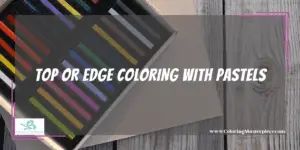Before discovering how to use soft pastels in coloring books it is a good idea to know what they are. Pastels are saturated-colored pigment powder that is combined with a binder. The result is sometimes formed into sticks or cakes. There are four basic kinds of pastel: soft pastel, pan pastel, hard pastel, and pencils with a pastel core. The last category is similar to colored pencils but with a slightly different core composition. In addition to these four types, there are also oil pastels and water-soluble pastels. The word “pastel” comes from late Latin, pastellus meaning paste, and from Medieval Latin, pastellum, meaning woad paste. Leonardo da Vinci learned of the dry pigment from a French artist, Jean Perréal. The French word pastel was first seen in print in 1662.
Blending Soft Pastels

If you’ve taken up coloring as an adult, or even if you are a kid sharing this article with a parent, you probably already know that you need a blending medium to blend either colored pencils or crayons, especially on the page. The beauty of soft pastels is that they are essentially colored chalks, just like those used on a chalkboard. The colors are a lot brighter (that’s where the saturated part comes in), and some brands might use materials that are not child-friendly. Some color sources, such as cadmium, that have been traditionally used in making artist pigments are not even human-friendly. Fortunately, modern science has given us substitutes for many of these substances. With that said, it is still not a good idea to stick your paintbrush in your mouth or to dampen the end of your colored pencil with your tongue.
Blending Soft Pastel Dust
Now, back to blending. One of the easiest ways to blend soft pastels is to hold a chalk pastel stick over your page, near the spot where you want the strongest color. Use an art knife or even a plastic knife to shave some dust off the side of the stick. Next, protect your finger with a tissue or makeup application pad, and gently rub the color into the page in the area where you want it to appear. The central location where the dust lands will be the darkest and the areas farthest from it are likely to be the lightest. To blend colors, scrape dust from two or more sticks. Stirring them about with your applicator (which can be your finger, but that gets a little messy) will mix the colors and you can even create different graduations of colors using this method. This is a splendid method for creating a smooth expanse of sky or water, with none of the pencil or crayon markings almost inevitable with colored pencils or wax crayons.
Side Stick Coloring with Pastels
This might sound like desecration to art supply purists who like to keep their precious medium intact, but this technique involves breaking one of your art sticks in half. Lay it on its side, and gently rub over the area you want to color. If you want to mix the colors, you can color over the same area with a different color or beside it. To blend the colors, simply rub them with a paper towel, a bit of toilet paper, a tortillon, or your finger. After all, fingers probably were the first paintbrushes.
Top or edge coloring with Pastels

Although pastels are not precision coloring tools, you can use the top or side to fill in relatively small spaces and get good results. You can use a small makeup applicator to blend tight areas.
Learn more about pastels HERE.
Using Pastels with Colored Pencils
Before beginning your project, check your pencils. Wax-based pencils, such as Prismacolor, will tend to mix with your pastels. Oil-based pencils such as Faber Castell will tend to act like a crayon resist with watercolor.
Try this experiment: Use a white or yellow colored pencil to draw a shape on a piece of art paper. Lightly dust the area with pastel dust. Gently rub with a makeup applicator or piece of tissue. As the pastel dust blends into the page, your drawing will pop. If the pencil was wax-based, the lines would take on the color of pastel dust. If it was oil-based, the lines would be clean and show up sharply.
You can use your pastels, either using the dust application method or lightly coloring and then rubbing, to create an attractive background for pictures. Then you can color the more delicate parts with pastel pencils, or standard colored pencils.
Using Pastels in Collage Work
Adult coloring does not have to be limited to coloring books. It can also be used in scrapbooks, in making cards, and in collage work. Although you do need to watch out for the dust from the pastels because it can make it difficult to get pieces to stick, if you are careful, you can make that super-blendable stuff part of your next scrapbook or collage project.
Ready to start your coloring masterpiece? Download my free adult coloring eBook and sign up for my email newsletter HERE!
Disclaimer: The information provided by ColoringMasterpiece.com (“The Site”) is for general informational purposes only. All information on the Site is provided in good faith, however, we make no representation or warranty of any kind, express or implied, regarding the accuracy, adequacy, validity, reliability, availability, or completeness of any information on the Site. Under no circumstance shall we have any liability to you for any loss or damage of any kind incurred as a result of the use of the Site or Reliance on any information provided on the Site. Your use of the Site and your reliance on any information on the Site is solely at your own risk. This blog post is for educational purposes only and does not constitute legal advice. Please consult a legal expert to address your specific needs.
Terms and Conditions: https://coloringmasterpiece.com/terms-and-conditions/
